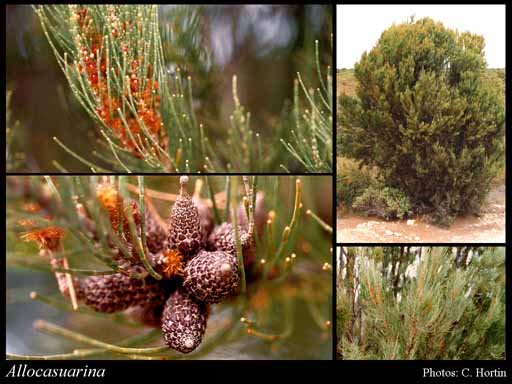- Reference
- J.Adelaide Bot.Gard. 6(1):73 (1982)
- Name Status
- Current







Scientific Description
Common name. Sheoaks. Family Casuarinaceae.
Habit and leaf form. Trees and shrubs (with ‘equisetiform’ shoots). Switch-plants; with the principal photosynthesizing function transferred to stems. Leaves much reduced. Leaves cauline. Leptocaul. Helophytic to xerophytic. Leaves minute; whorled; 4–14 per whorl; membranous; sessile; connate; aromatic (pungent), or without marked odour; simple. Leaf blades entire. Leaves without stipules. Stem anatomy. Secondary thickening developing from a conventional cambial ring.
Reproductive type, pollination. Fertile flowers functionally male and functionally female, or functionally male, or functionally female. Unisexual flowers present. Plants monoecious, or dioecious. The unisexual flowers when monoecious, segregated in different inflorescences. Female flowers without staminodes. Anemophilous.
Inflorescence and flower features. Flowers solitary (in axils), or aggregated in ‘inflorescences’; in spikes, or in heads. Inflorescences terminal, or axillary (male flowers in axils of spike); of male flowers in simple short to long spikes, on branchlets which in the flowering region are usually distinctively different from the vegetative branchlets; of females on short lateral branches or more or less sessile. The fruiting inflorescence conelike. Flowers sessile; bracteate; bracteolate; small. Hypogynous disk absent. Perianth vestigial (male flowers), or absent (females); 1–2 (of scales, in male flowers only). Fertile stamens present, or absent. Androecial members definite in number. Androecium 1. Androecial members unbranched (but tending to split); adnate. Androecium exclusively of fertile stamens. Stamens 1. Anthers basifixed; dehiscing via longitudinal slits. Fertile gynoecium present, or absent. Gynoecium 2 carpelled. The pistil 2 celled. Gynoecium syncarpous; synstylovarious; superior. Ovary plurilocular; 2 locular. Gynoecium stylate. Styles 1; apical. Stigmas 2. Ovules 2 per locule; collateral; non-arillate; orthotropous.
Fruit and seed features. Fruit non-fleshy; indehiscent; a nut and a samara (single seeded, terminally winged). Gynoecia of adjoining flowers combining to form a multiple fruit. The multiple fruits not coalescing. Fruit 1 seeded. Seeds non-endospermic. Embryo well differentiated. Cotyledons 2 (oily). Embryo straight.
Etymology. From the Greek for "other" and neo-Latin Casuarina, referring to the relationship with the genus Casuarina.
Taxonomic Literature
- Wege, Juliet A. 2007. Allocasuarina hystricosa (Casuarinaceae) : a new species from south-west Western Australia, with notes on related species.
- Wheeler, Judy; Marchant, Neville; Lewington, Margaret; Graham, Lorraine 2002. Flora of the south west, Bunbury, Augusta, Denmark. Volume 2, dicotyledons. Australian Biological Resources Study.. Canberra..
- Australia. Bureau of Flora and Fauna 1989. Flora of Australia. Volume 3, Hamamelidales to Casuarinales. Australian Govt. Pub. Service.. Canberra..
- Blackall, William E.; Grieve, Brian J. 1988. How to know Western Australian wildflowers : a key to the flora of the extratropical regions of Western Australia. Part I : Dicotyledons (Casuarinaceae to Chenopodiaceae). University of W.A. Press.. [Perth]..